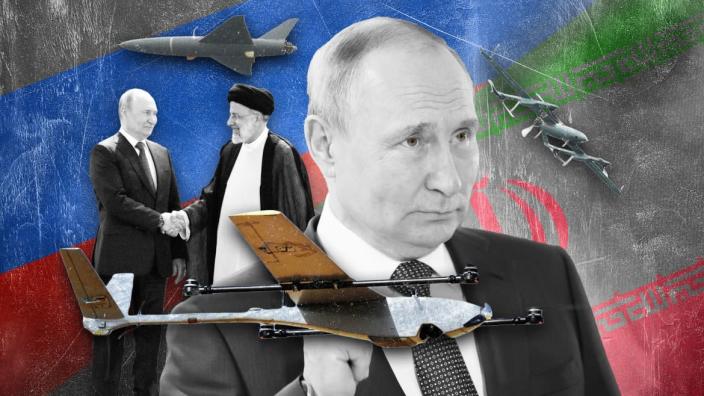
U.S. National Security Adviser Jake Sullivan made a startling announcement earlier this month: that Russia is getting hundreds of drones from Iran, and will begin training with them within weeks.
A major U.S. adversary selling a swarm of drones to another sounds like something out of a Tom Clancy novel—but will the move give Russia the edge it needs to fundamentally change the course of its war in Ukraine?
For all the histrionics, the drone purchase could have as much to do with desperation as collusion. As frightened as the Pentagon and U.S. officials are of countries like Russia, Venezuela, Iran, North Korea, and others working together, the nature of this deal seems much more in the realm of opportunism by Iran and desperation by Russia than the start of some grand Iran-Russia engagement.
Russia’s domestic drone program is lackluster, its industry is struggling to replace equipment losses, and Israel, Russia’s traditional drone partner, is distancing itself from both parties to the conflict. Given that U.S.-aligned drone manufacturers like Turkey are unlikely to sell drones to Russia, only Iran has the domestic drone industry, interest in proliferation, and lack of concern about political backlash to pull this move off.
Transferring hundreds of drones is concerning, but the types of drones sent matters a lot.
Putin Should Be Very Worried About Ukraine’s New Kamikaze Drone
Iran manufactures dozens of different kinds of drones, from minuscule kamikaze drones to the large strike platforms most people picture when they think of drone warfare. A 2019 overview of the Iranian military by the U.S. Defense Intelligence Agency noted that drones “are Iran’s most rapidly advancing air capability” and their drones can perform intelligence, surveillance, and reconnaissance, fire munitions, or crash into a target and detonate. Most recently, they’ve shown a capacity to launch drones from surface vessels, which extends their strike range.
Iran’s Army chief, Major General Abdolrahim Mousavi and Iranian Armed Forces Chief of Staff, Major General Mohammad Bagheri visit an underground site with drones at an undisclosed location in Iran on May 28, 2022.
” data-src=”https://s.yimg.com/ny/api/res/1.2/ymzxgXAnWuLVSqeN8JE5VQ–/YXBwaWQ9aGlnaGxhbmRlcjt3PTcwNTtoPTQ3MA–/https://s.yimg.com/uu/api/res/1.2/XOtDQtEQOakPcaj3asew8A–~B/aD03ODA7dz0xMTcwO2FwcGlkPXl0YWNoeW9u/https://media.zenfs.com/en/thedailybeast.com/0ad148e9354601ee5ebd490fda154f1f”><img alt="
Iran’s Army chief, Major General Abdolrahim Mousavi and Iranian Armed Forces Chief of Staff, Major General Mohammad Bagheri visit an underground site with drones at an undisclosed location in Iran on May 28, 2022.
” src=”https://s.yimg.com/ny/api/res/1.2/ymzxgXAnWuLVSqeN8JE5VQ–/YXBwaWQ9aGlnaGxhbmRlcjt3PTcwNTtoPTQ3MA–/https://s.yimg.com/uu/api/res/1.2/XOtDQtEQOakPcaj3asew8A–~B/aD03ODA7dz0xMTcwO2FwcGlkPXl0YWNoeW9u/https://media.zenfs.com/en/thedailybeast.com/0ad148e9354601ee5ebd490fda154f1f” class=”caas-img”>
Iran’s Army chief, Major General Abdolrahim Mousavi and Iranian Armed Forces Chief of Staff, Major General Mohammad Bagheri visit an underground site with drones at an undisclosed location in Iran on May 28, 2022.
Iranian Army/WANA/Reuters
Sullivan’s announcement provided some hints as to what kinds of drones Iran may be providing. U.S. officials claim Iran showcased the Shahed-191 and the Shahed-129 for a Russian delegation in June. Unlike Iran’s simple Kamikaze drones, which run into their target and explode, the 191 and 129 are capable of long-range reconnaissance (ISR) and firing munitions, with the latter resembling the infamous U.S. MQ-1 Predator drone.
While a worst-case scenario for Ukraine would be Iran transferring their most capable drones en masse to Russia, it is more likely that Tehran would want to shepherd their newest systems and send more expendable platforms instead.
In particular, the U.S. announcement mentioned that some of the drones were weapons-capable, like those Iran supplies to the Houthi rebels in Yemen. The Houthis have made extraordinary use of Iranian-provided drones to attack military targets in Yemen, attempt to assassinate leaders at public events, and attack Saudi Arabia’s oil facilities. According to the UN, the major systems used by the Houthis are the Ababil and Samad families, both of which have ISR capabilities and kamikaze variants, but are not as capable as the Shahed-191 and 129, which can do ISR missions, fire munitions, and return for reuse. If Iran already produces these cheaper systems in large quantities to supply them to the Houthis, then it would not be difficult or risky for Tehran to sell many to Moscow, while also providing a smaller number of 191s and 129s.
Dad Says Botched U.S. Drone Strike Could Now Cost Him His Legs
The big question is whether Iran’s drones are an indicator that Russia is short on its own supply of drones. Artillery is key to Russia’s advance, and drones with long-distance strike capabilities would allow Russia to locate targets and correct artillery fire in real time. By some estimates, Russia has lost dozens of its own ISR drones, like the Orlan-10. At the same time, the Iranian drones are no less impervious to Ukrainian anti-aircraft systems, prompting the question of how much longer they would last than the Orlans once deployed.
A drone is launched during a large-scale drone combat exercise of Army of the Islamic Republic of Iran, in Semnan, Iran on January 4, 2021.
” data-src=”https://s.yimg.com/ny/api/res/1.2/_fnN6Qip.0OewBSoKYFBbw–/YXBwaWQ9aGlnaGxhbmRlcjt3PTcwNTtoPTQ3MA–/https://s.yimg.com/uu/api/res/1.2/kPcIK_Ow02CVUKM.f2KO2A–~B/aD03ODA7dz0xMTcwO2FwcGlkPXl0YWNoeW9u/https://media.zenfs.com/en/thedailybeast.com/db8c9f281d31d61f9dfc7be48d25c10d”><img alt="
A drone is launched during a large-scale drone combat exercise of Army of the Islamic Republic of Iran, in Semnan, Iran on January 4, 2021.
” src=”https://s.yimg.com/ny/api/res/1.2/_fnN6Qip.0OewBSoKYFBbw–/YXBwaWQ9aGlnaGxhbmRlcjt3PTcwNTtoPTQ3MA–/https://s.yimg.com/uu/api/res/1.2/kPcIK_Ow02CVUKM.f2KO2A–~B/aD03ODA7dz0xMTcwO2FwcGlkPXl0YWNoeW9u/https://media.zenfs.com/en/thedailybeast.com/db8c9f281d31d61f9dfc7be48d25c10d” class=”caas-img”>
A drone is launched during a large-scale drone combat exercise of Army of the Islamic Republic of Iran, in Semnan, Iran on January 4, 2021.
Iranian Army/WANA/Reuters
It’s also possible the drones will supplement Russia’s long-range strike options to make their larger weapons more effective. The Houthis often claim they use their drones in concert with missiles, presumably to complicate air defenses for Saudi Arabia. Russia’s own Kamikaze drone appears to be in short supply, and lacks the range to strike targets deep into Ukraine. Kamikaze drones could prove to be a problem for Ukraine’s beleaguered air defenses, particularly once they get across the front line.
Overall, Ukraine is right to be concerned that Russia can now procure more drones from abroad, but there is a limit to how much damage they can do tactically, and likely won’t make much of a difference strategically.
But if Iran begins transferring more sophisticated UAVs, assists with smuggling components that Russia is short of, or perhaps negotiates the sale of other stand-off weapons like missiles—all bets could be off the table.
Get the Daily Beast’s biggest scoops and scandals delivered right to your inbox. Sign up now.
Stay informed and gain unlimited access to the Daily Beast’s unmatched reporting. Subscribe now.




